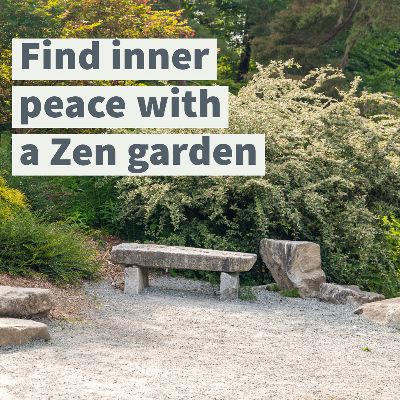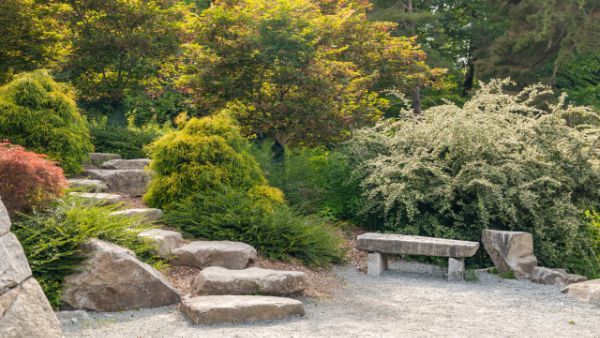Find Your Zen: The Perfect Zen Garden for Your Backyard

Contents
Introduction
Zen gardens are a beautiful and peaceful addition to any home. They offer a place of relaxation, meditation, and connection with nature. With the right tools and materials, creating your own Zen garden can be an enjoyable and rewarding experience.
In this guide, we will walk you through the steps of planning and preparing, selecting the right tools and materials, designing, and building your own Zen garden. We’ll also provide tips for maintaining your garden and inspiration from some of the most beautiful Zen garden designs.
So, let’s get started on creating your own oasis of peace and tranquility.
What Is a Zen Garden
Zen gardens, also known as karesansui or Japanese rock gardens, are miniature landscapes created for meditation, contemplation, and aesthetic enjoyment. Originating in Japan, Zen gardens have been used by Buddhist monks for centuries as a tool for mindfulness and self-reflection. In this section, we’ll delve into the definition, history, purpose, and benefits of Zen gardens.
Definition of a Zen Garden
A Zen garden is a compact and stylized representation of nature, typically featuring elements such as sand, rocks, and gravel, as well as elements of water and greenery. The simplicity and symmetry of Zen gardens invite visitors to slow down, breathe deeply, and reflect on the beauty and stillness of the natural world.
History of Zen Gardens
Zen gardens have a long and rich history dating back to the 14th century in Japan. They were created by Buddhist monks as a tool for meditation and reflection and evoked the peacefulness and serenity of the natural world. Over time, Zen gardens evolved into sophisticated landscapes, incorporating elements such as bridges, lanterns, and water features.
Purpose of Zen Gardens
The primary purpose of a Zen garden is to provide a space for stillness, contemplation, and reflection. By slowing down and focusing on the beauty of the natural world, Zen gardens can help promote mindfulness, reduce stress, and increase overall well-being. We can use them for personal meditation or for communal gatherings and serve as a reminder of the simple beauty and peace that can be found in nature.
Benefits of having a Zen Garden
There are many benefits to having a Zen garden, including reduced stress and increased relaxation. Zen gardens can also help improve focus and concentration and provide a space for personal reflection and contemplation. They can serve as a calming presence in a busy environment, and promote feelings of peace and serenity. Whether you create a small tabletop garden or a large outdoor landscape, a Zen garden can provide a peaceful and calming refuge in your home or workplace.
If you are getting valie from the advice and inspiration in this blog post, you’ll love ‘Japanese Gardens’ by Geeta Mehta and Kimie Tada, a must-have book for any gardening or zen enthusiast looking to appreciate the natural beauty and cultural significance of Japanese gardens.
Step into the serene world of Japanese gardens with “Japanese Gardens” by Geeta Mehta and Kimie Tada. This beautiful book showcases over 20 quintessentially Japanese gardens, providing insightful commentary and exquisite photography that captures the natural beauty and cultural significance of each one. Whether you’re a gardening or zen enthusiast, or simply looking to appreciate the harmony between nature and human culture, “Japanese Gardens” is a must-have book that will transport you to a world of peace and tranquility.
Understanding the Essential Elements of a Zen Garden
We know Zen gardens for their simple and elegant design, but each element of a Zen garden holds a specific purpose and significance. In this section, we’ll explore the essential elements of a Zen garden, including sand and gravel, rocks and stones, water and greenery, bridges and paths, and lanterns and other accents.
Sand and Gravel
Sand and gravel are the foundation of a Zen garden, and are meant to represent the oceans, rivers, and valleys of the natural world. In a Zen garden, the sand or gravel is often raked into intricate patterns, representing the flow of water and the ebb and flow of the tides.
Rocks and Stones
Rocks and stones are often used in Zen gardens to represent mountains, cliffs, and other natural formations. They can be placed in groups or individually and are meant to evoke the stillness and stability of the natural world.
Water and Greenery
Water and greenery are essential elements in a Zen garden, representing the life and growth that are found in nature. A small pond, stream, or even a simple rock formation can represent water, while a small tree or shrub can represent greenery.
Bridges and Paths
Bridges and paths in Zen gardens symbolize the journey through life and the paths that we take toward enlightenment. They can be made from a variety of materials, including stone, wood, or bamboo, and can connect elements of the garden.
Lanterns and Other Accents
Lanterns and other accents, such as stone or metal sculptures, can add an extra layer of detail to a Zen garden. They represent the light of knowledge and the path to enlightenment. Whether they are placed near water features or tucked away in quiet corners, these accents enhance the overall atmosphere of the garden.
By understanding the essential elements of a Zen garden, you can create your own peaceful and calming landscape, and bring a sense of serenity and stillness into your life.
The Importance of Balance and Symmetry in a Zen Garden
Balance and symmetry play a crucial role in the design of a Zen garden. These elements are not only aesthetically pleasing but also evoke a sense of calm and tranquility, making a Zen garden the perfect place for reflection and meditation.
Achieving Balance through Design
Balance in a Zen garden can be achieved through the careful placement of rocks, stones, and other elements. Whether you choose to arrange these elements symmetrically or asymmetrically, the goal is to create a sense of balance and stability in the garden. For example, if you have a large rock on one side of the garden, place a smaller rock on the other side to balance the composition.
The Significance of Symmetry
Symmetry is an important aspect of many traditional Zen gardens and is often used to evoke a sense of order and peace. In a symmetrical Zen garden, elements are placed in a repeating pattern, with the same elements appearing on either side of the garden. This repetition serves to create a sense of harmony and balance and provides a visual focal point for the garden.
Tips for Incorporating Balance and Symmetry in Your Zen Garden
Whether you’re creating a traditional Zen garden or a more modern design, incorporating balance and symmetry into your garden is key to achieving a sense of peace and tranquility.
- Start with a simple design, such as a grid or a repeating pattern, and build from there.
- Use rocks, stones, and other elements to create a sense of balance, either symmetrically or asymmetrically.
- Consider using water or greenery to add a sense of life and movement to the garden.
- Pay attention when placing elements, and try to create a balanced composition.
By incorporating balance and symmetry into your Zen garden design, you can create a peaceful and calming landscape that provides the perfect space for reflection and meditation. Whether you choose to design a traditional Zen garden or a more modern landscape, these elements will help you create a sense of order and tranquility in your garden.
Steps for Creating Your Zen Garden
Choose a Location for Your Garden
Finding the right location for your Zen garden is an important step in creating a peaceful and reflective space. Ideally, your Zen garden should be in a secluded area, but it can be virtually anywhere if necessary.
- Consider factors such as size, sunlight, and access
- When selecting your location, consider the size of your garden, the amount of sunlight it will receive, and access to water for maintenance. If possible, choose an area that is away from heavy foot traffic, providing a quiet escape from the hustle and bustle of daily life.
The type of soil and moisture retention in the area should also be considered. This information will be useful when it comes time to prepare the soil and lay out your garden.
Despite these considerations, it’s essential to remember that a Zen garden can be created virtually anywhere, even in areas that receive little sunlight or are very arid. With sand or gravel as the base, you can still create a beautiful and serene Zen garden that is both practical and peaceful.
Adding the Essential Elements of Your Zen Garden
Rocks, Sand, Gravel, and More
The rocks, sand, gravel, and other elements are the foundation of your Zen garden. These elements will serve as the backdrop for all the other elements you choose to add, so it is important to choose the right combination of materials.
When adding rocks, sand, and gravel to your garden, it is important to consider their placement and balance. A balanced arrangement will create a sense of calm and tranquility, while an imbalanced arrangement will feel chaotic and unrefined.
Importance of Placement and Balance
Placement and balance are key elements of a Zen garden. The rocks, sand, and gravel should be arranged in a way that creates a sense of order and symmetry. This sense of balance can be achieved by using a mix of large and small rocks, spreading the sand evenly, and using a consistent pattern for the gravel.
It is important to consider the placement of the rocks, sand, and gravel in relation to each other. For example, try placing a large rock in the center of your garden and arranging smaller rocks around it. This will create a sense of balance and focus for your garden.
The importance of placement and balance in a Zen garden cannot be overstated. A garden that is well-balanced and thoughtfully arranged will have a greater impact on your overall sense of peace and well-being.
Adding Optional Features to Your Zen Garden
A Zen Garden can be a simple and minimalistic landscape or it can be enhanced with additional features to create more interest and a deeper sense of serenity. Some popular optional features to consider include bridges, water features, and small sculptures.
Bridges in a Zen Garden can symbolize the crossing of a threshold or the journey from one place to another. They can be made of various materials including wood, bamboo, or stone, and can be simple or intricate in design. Bridges can cross small streams or connect different areas of the garden.
Water features in a Zen Garden can bring a calming and soothing sound to the space. A simple water feature can be a small pond or a fountain, while a more elaborate water feature could include a stream or waterfall. Water features can be an excellent way to bring life and movement to a Zen Garden and can also provide a habitat for local wildlife.
Small sculptures and other decorative elements can also be added to a Zen Garden. These elements can create focal points or add interest and depth to the garden. Common sculptures include stones stacked in interesting formations, small statues, or even birdhouses.
Adding optional features to a Zen Garden can add a sense of interest and depth, making it a more dynamic and engaging space. Whether it’s a bridge, water feature, or small sculpture, these elements can bring a deeper sense of peace and tranquility to the garden.
Tips for Maintaining Your Zen Garden
Regular Cleaning and Raking
One of the most important aspects of maintaining a Zen garden is regularly cleaning and raking the sand and gravel. This helps to keep the garden looking neat and also encourages the flow of energy. It’s also important to keep in mind that the raking pattern should be different each time you clean the garden, as this adds to the sense of balance and symmetry that is central to the Zen garden aesthetic.
Care for Plants and Water Features
If you’ve added plants or water features to your Zen garden, it’s important to take care of them properly. This may include watering the plants, removing any dead leaves or branches, and ensuring that the water in your water feature is clear. Taking care of these elements will help them thrive and will also help to keep your Zen garden looking its best.
Dealing with Natural Elements
It’s also important to consider how natural elements such as rain and wind can affect your Zen garden. For example, rain can erode the sand and gravel and cause them to shift out of place, so it’s important to have a plan in place for dealing with this. Similarly, wind can cause debris to collect in your garden, so it’s important to regularly clean and maintain it. By taking these factors into account, you can ensure that your Zen garden remains beautiful and peaceful for years to come
Conclusion
Embracing Tranquility: The Final Thoughts on Creating Your Own Zen Garden
A Zen Garden can bring a sense of peace, calm, and balance to your life. The creation process can be an enjoyable and meditative experience that allows you to let go of daily stress and immerse yourself in the beauty of nature. Whether you have a large outdoor space or a small indoor area, with a little bit of creativity and effort, you can create a Zen Garden tailored to your own needs and preferences.
The benefits of having a Zen Garden are many and include reducing stress, improving mental clarity and focus, and providing a sense of inner peace. The steps to creating a Zen Garden include choosing a location, preparing the area, adding essential elements such as rocks, sand, and gravel and optional features like bridges or water features, and maintaining the garden with regular cleaning and care.
Whether you choose to create a simple and minimalist garden or a more elaborate and intricate one, the important thing is to take the time to create a space that brings you peace and joy.
So why not start today and enjoy the beauty of a Zen Garden in your own life?

Ian Sparrow
Hi l am a part time blogger, affiliate marketer and founder of Bestdesigneye.com. I post content on niche website design, WordPress and SEO.


